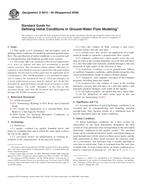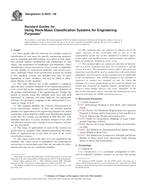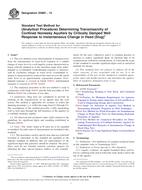Potrebujeme váš súhlas na využitie jednotlivých dát, aby sa vám okrem iného mohli ukazovať informácie týkajúce sa vašich záujmov. Súhlas udelíte kliknutím na tlačidlo „OK“.
ASTM D6431-99(2010)
Standard Guide for Using the Direct Current Resistivity Method for Subsurface Investigation
Automaticky preložený názov:
Štandardné Guide pre použitie jednosmerného merného odporu metódy pre podpovrchovej vyšetrovanie
NORMA vydaná dňa 1.5.2010
Informácie o norme:
Označenie normy: ASTM D6431-99(2010)
Poznámka: NEPLATNÁ
Dátum vydania normy: 1.5.2010
Kód tovaru: NS-35119
Počet strán: 14
Približná hmotnosť: 42 g (0.09 libier)
Krajina: Americká technická norma
Kategória: Technické normy ASTM
Kategórie - podobné normy:
Anotácia textu normy ASTM D6431-99(2010) :
Keywords:
electrical method, geophysics, resistivity, subsurface investigation, surface geophysics: Direct current resistivity method, Subsurface investigation--soil/rock, ICS Number Code 07.060 (Geology. Meteorology. Hydrology)
Doplňujúce informácie
| Significance and Use | ||||||||||||||||||||||||||||||||||||||||||||||||||||||||
|
Concepts—The resistivity technique is used to measure the resistivity of subsurface materials. Although the resistivity of materials can be a good indicator of the type of subsurface material present, it is not a unique indicator. While the resistivity method is used to measure the resistivity of earth materials, it is the interpreter who, based on knowledge of local geologic conditions and other data, must interpret resistivity data and arrive at a reasonable geologic and hydrologic interpretation. Parameter Being Measured and Representative Values: Table 1 shows some general trends for resistivity values. Fig. 2 shows ranges in resistivity values for subsurface materials. Materials with either a low effective porosity or that lack conductive pore fluids have a relatively high resistivity (>1000 Ωm). These materials include massive limestones, most unfractured igneous rocks, unsaturated unconsolidated materials, and ice. Materials that have high porosity with conductive pore fluids or that consist of or contain clays usually have low resistivity. These include clay soil and weathered rock. Materials whose pore water has low salinity have moderately high resistivity. The dependence of resistivity on water saturation is not linear. Resistivity increases relatively little as saturation decreases from 100 % to 40-60 % and then increases much more as saturation continues to decrease. An empirical relationship known as Archie's Law describes the relationship between pore fluid resistivity, porosity, and bulk resistivity (McNeill (8)). Equipment—Geophysical apparatus used for surface resistivity measurement includes a source of power, a means to measure the current, a high impedance voltmeter, electrodes to make contact with the ground, and the necessary cables to connect the electrodes to the power sources and the volt meter (Fig. 1). While resistivity measurements can be made using common electronic instruments, it is recommended that commercial resistivity instruments specifically designed for the purpose be used for resistivity measurements in the field. Commonly used equipment includes the following elements: A source of current consisting of batteries or a generator, A high-impedance voltmeter or resistivity unit, Metal stakes for the current and potential electrodes, and Insulated wire to connect together all of the preceding components. Care must be taken to ensure good electrical contact of the electrodes with the ground. Electrodes should be driven into the ground until they are in firm contact. If connections between electrodes and the insulated wire are not waterproof, care must be taken to ensure that they will not be shorted out by moisture. Special waterproof cables and connectors are required for wet areas. A large variety of resistivity systems are available from different manufacturers. Relatively inexpensive battery-powered units are available for shallow surveys. The current source (transmitter) and the potential measurement instrument (receiver) are often assembled into a single, portable unit. In some cases, the transmitter and receiver units are separate. High power units capable of deep survey work are powered by generators. The current used in dc resistivity surveys varies from a few milliamps to several amps, depending on the depth of the investigation. Signal Enhancement—Signal enhancement capability is available in many resistivity systems. It is a significant aid when working in noisy areas or with low power sources. Enhancement is accomplished by adding the results from a number of measurements at the same station. This process increases the signal-to-noise ratio. Limitations and Interferences: Limitations Inherent to Geophysical Methods: A fundamental limitation of all geophysical methods lies in the fact that a given set of data cannot be associated with a unique set of subsurface conditions. In most situations, surface geophysical measurements alone cannot resolve all ambiguities, and some additional information, such as borehole data, is required. Because of this inherent limitation in geophysical methods, a resistivity survey alone is never considered a complete assessment of subsurface conditions. Properly integrated with other information, resistivity surveying is an effective method of obtaining subsurface information. All surface geophysical methods are inherently limited by decreasing resolution with depth. Limitations Specific to the Resistivity Method: Interpretation methods assume horizontal (or parallel) layered conditions where each layer has a uniform electrical resistivity. If subsurface conditions cannot be reasonably approximated by this assumption, then results will be in error. Thin layers or multiple layers with similar resistivities may not be detected. Ambiguities in interpretation arising from equivalence (where two resistive layers carry nearly the same electric current if the products of their resistivity and thickness equal). Ambiguities in interpretation arising from suppression (where resistant layers are sandwiched between more conductive layers). Extremely resistive materials will prevent current injection into the ground. Interferences Caused by Ambient and Geologic Conditions: The resistivity method is sensitive to electrical interference from a variety of sources. It is inherently sensitive to electrical interference. Spatial variables caused by geologic factors and cultural factors may also produce noise. Ambient Sources of Noise—Natural (ambient) sources of noise include lightning or natural earth currents, which may induce a voltage in resistivity cables. Geologic Sources of Noise—Geologic sources of noise include local inhomogeneities near electrodes that may result in measurement error and variations in the subsurface that are not the object of the survey. Cultural Sources of Noise—Resistivity measurements may be influenced by nearby cultural features (such as power lines, radio stations, cathodic pipeline protection, and other geophysical equipment) that generate electrical or electromagnetic fields. Pipelines, fences, and metal buildings may also affect them. Leakage—A resistivity measurement may also be affected by leakage from the insulated wire used to connect the instrument to the electrodes. Tests for leakage can be made at the time of the measurement. Summary—During the course of designing survey locations, potential cultural interferences should be considered. During the survey, the occurrence of electrical interferences should be noted. Alternate Methods—The limitations previously discussed may prohibit the effective use of the resistivity method, and other methods may be required to resolve the problem. An alternative to the resistivity method is the EM method, which is preferred in high-resistivity (low-conductivity) materials, and may require less space to conduct the survey. Electrode Array Geometry—Usually the electrodes are arranged in a collinear array in one of several fixed geometries. Several standard electrode geometries have been developed for various applications (Fig. 3). For engineering, environmental, and groundwater studies, the Wenner, Schlumberger, and dipole-dipole arrays are the most commonly used. Wenner Array—The Wenner array consists of
equally spaced, in-line electrodes (Fig. 3). The formula for
calculating apparent resistivity from a Wenner measurement is:
Schlumberger Array—The Schlumberger array
consists of unequally spaced in-line electrodes (Fig. 3), where
AB > 5 MN. The formula for calculating apparent
resistivity from a Schlumberger measurement is:
Dipole-Dipole Array—The dipole-dipole array
consists of a pair of closely spaced current electrodes and a pair
of closely spaced potential electrodes (Fig. 3). The formula for
calculating apparent resistivity from a dipole-dipole measurement
is:
Comparison of the Arrays: The advantages of Schlumberger arrays: (1) Schlumberger arrays are less susceptible to contact problems and the influence of nearby geologic conditions that may affect readings. The method provides a means to recognize the effects of lateral variations and to partially correct for them. (2) Schlumberger arrays are slightly faster in field operations since only the current electrodes must be moved between readings. Advantages of Wenner Arrays: (1) The Wenner array provides a higher signal to noise ratio than other arrays because its potential electrodes are always farther apart and located between the current electrodes. As a result, the Wenner array measures a larger voltage for a given current than is measured with other arrays. (2) This array is good in high-noise environments such as urban areas. (3) This array requires less current for a given depth capability. This translates into less severe instrumentation requirements for a given depth capability. Advantages of Dipole-Dipole Arrays: (1) Relatively short cable lengths are required to explore large depths. (2) Short cable lengths reduce current leakage. (3) More detailed information on the direction of dip of electrical horizons is obtainable. Other Arrays—There are several other arrays: Lee-partitioning array (Zohdy et al (2)), square array (Lane et al (9)), gradient array (Ward (2)) and pole-dipole (Ward (5)) and automated data acquisition and imaging systems that are not discussed in this guideline. Sounding (Depth) Measurements—Sounding measurements are one of the most widespread uses for the resistivity technique. Soundings provide a means of measuring changes of electrical resistivity with depth at a single location. Several measurements are made with increasing electrode spacings. As the spacing of the electrodes is increased, there is an increase in the depth and volume of material measured (Fig. 4). The center point of the array remains fixed as the electrical spacing is increased. This method can be used to determine changes in lithology, stratigraphy, and depth to water table. These depths are interpreted from measurements of apparent resistivity. Sounding measurements result in a series of apparent electrical resistivity values at various electrode spacings. These apparent resistivity values are plotted against electrode spacing using a log-log scale (Fig. 5) and are interpreted using inversion techniques to derive true resistivity and thickness of subsurface layers. Successive electrode spacings should be (approximately) equally spaced on a logarithmic scale. Normally, 3 to 6 data points per decade should be measured. A resistivity sounding curve obtained from measurements of a uniform layered medium should follow a smooth curve, (Fig. 5). By using six points per decade, noise is generally less significant and a smooth sounding curve may be obtained. Data should be plotted in the field to ensure that an adequate number of noise-free measurements are made. The depth of penetration for an inhomogeneous stratified earth depends upon the electrode separation and the resistivities of the earth's layers. In general, the overall array length could be many times the exploration depth. Profiling Measurements—A series of profile measurements along a line is used to assess lateral changes in subsurface conditions at a given depth (Fig. 6). Electrical resistivity profiling is accomplished by making measurements with fixed electrode spacing and array geometry at several stations along a profile line (Fig. 7). A single profile measurement results in an apparent electrical resistivity value at a station. Several profiles over an area can be used to produce a contour map of changes in subsurface conditions (Fig. 8). These apparent resistivity profiles or maps can not be interpreted in terms of layer resistivity values without sounding data or other additional information. Vertical soundings are used to determine the appropriate electrode spacing for profiling. Small electrode spacings can be used to emphasize shallow variations in resistivity that may affect the interpretation of deeper data. Spacing between measurements controls the lateral resolution that can be obtained from a series of profile measurements. TABLE 1 Representative Resistivity Values for Soil, Water, and Rock (Mooney (4))
|
||||||||||||||||||||||||||||||||||||||||||||||||||||||||
| 1. Scope | ||||||||||||||||||||||||||||||||||||||||||||||||||||||||
|
1.1 Purpose and Application: 1.1.1 This guide summarizes the equipment, field procedures, and interpretation methods for the assessment of the electrical properties of subsurface materials and their pore fluids, using the direct current (DC) resistivity method. Measurements of the electrical properties of subsurface materials are made from the land surface and yield an apparent resistivity. These data can then be interpreted to yield an estimate of the depth, thickness, and resistivity of subsurface layer(s). 1.1.2 Resistivity measurements as described in this guide are applied in geological, geotechnical, environmental, and hydrologic investigations. The resistivity method is used to map geologic features such as lithology, structure, fractures, and stratigraphy; hydrologic features such as depth to water table, depth to aquitard, and groundwater salinity; and to delineate groundwater contaminants. General references are, Keller and Frischknecht (1), Zohdy et al (2), Koefoed (3), EPA (4), Ward (5), Griffiths and King (6), and Telford et al (7). 1.2 Limitations: 1.2.1 This guide provides an overview of the Direct Current Resistivity Method. It does not address in detail the theory, field procedures, or interpretation of the data. Numerous references are included for that purpose and are considered an essential part of this guide. It is recommended that the user of the resistivity method be familiar with the references cited in the text and with the Guide D420, Practice D5088, Practice D5608, Guide D5730, Test Method G57, D6429, and D6235. 1.2.2 This guide is limited to the commonly used approach for resistivity measurements using sounding and profiling techniques with the Schlumberger, Wenner, or dipole-dipole arrays and modifications to those arrays. It does not cover the use of a wide range of specialized arrays. It also does not include the use of spontaneous potential (SP) measurements, induced polarization (IP) measurements, or complex resistivity methods. 1.2.3 The resistivity method has been adapted for a number of special uses, on land, within a borehole, or on water. Discussions of these adaptations of resistivity measurements are not included in this guide. 1.2.4 The approaches suggested in this guide for the resistivity method are the most commonly used, widely accepted and proven; however, other approaches or modifications to the resistivity method that are technically sound may be substituted if technically justified and documented. 1.2.5 This guide offers an organized collection of information or a series of options and does not recommend a specific course of action. This document cannot replace education or experience and should be used in conjunction with professional judgements. Not all aspects of this guide may be applicable in all circumstances. This ASTM standard is not intended to represent or replace the standard of care by which the adequacy of a given professional service must be judged, nor should this document be applied without consideration of a project's many unique aspects. The word “Standard” in the title of this document means only that the document has been approved through the ASTM consensus process. 1.3 Precautions: 1.3.1 It is the responsibility of the user of this guide to follow any precautions in the equipment manufacturer's recommendations and to consider the safety implications when high voltages and currents are used. 1.3.2 If this guide is used at sites with hazardous materials, operations, or equipment, it is the responsibility of the user of this guide to establish appropriate safety and health practices and to determine the applicability of regulations prior to use. 1.4 This standard does not purport to address all of the safety concerns, if any, associated with its use. It is the responsibility of the user of this standard to establish appropriate safety and health practices and determine the applicability of regulatory limitations prior to use. |
||||||||||||||||||||||||||||||||||||||||||||||||||||||||
| 2. Referenced Documents | ||||||||||||||||||||||||||||||||||||||||||||||||||||||||
|
||||||||||||||||||||||||||||||||||||||||||||||||||||||||
Podobné normy:
Historická
15.9.2008
Historická
15.9.2008
Historická
1.10.2011
Historická
1.7.2008
Historická
15.11.2013
Historická
1.6.2014
Odporúčame:
Aktualizácia technických noriem
Chcete mať istotu, že používate len platné technické normy?
Ponúkame Vám riešenie, ktoré Vám zaistí mesačný prehľad o aktuálnosti noriem, ktoré používate.
Chcete vedieť viac informácií ? Pozrite sa na túto stránku.



 ASTM D5609-94(2008)..
ASTM D5609-94(2008).. ASTM D5610-94(2008)..
ASTM D5610-94(2008).. ASTM D5741-96(2011)..
ASTM D5741-96(2011).. ASTM D5878-08
ASTM D5878-08 ASTM D5881-13
ASTM D5881-13 ASTM D5920-14
ASTM D5920-14
 Cookies
Cookies
